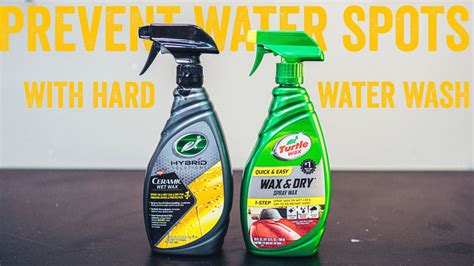Prevent Water Spots and Keep Your Car Looking New
Water spots. Those pesky little blemishes that mar the pristine finish of your beloved car. They're not just unsightly; they can actually damage your car's paint over time, leading to dullness and even rust. But don't despair! With the right techniques and products, you can effectively prevent water spots and keep your car looking showroom-fresh for years to come.
What Causes Water Spots?
Before we dive into prevention, let's understand the enemy. Water spots are primarily caused by mineral deposits left behind after water evaporates on your car's surface. Hard water, rich in minerals like calcium and magnesium, is the biggest culprit. These minerals adhere to the paint, creating those unsightly spots. The sun's heat accelerates the evaporation process, making the problem worse.
How to Prevent Water Spots on Your Car
Preventing water spots requires a multi-pronged approach. Here’s a breakdown of effective strategies:
1. Washing Your Car Properly: The Foundation of Prevention
The most crucial step in preventing water spots is washing your car correctly. Avoid using harsh soaps or detergents, as these can strip away protective waxes and sealants, leaving your paint vulnerable. Opt for a dedicated car wash soap formulated to be gentle on your car's finish.
-
Two-Bucket Method: Employ the two-bucket method to prevent recontamination. One bucket contains soapy water, and the other contains clean water for rinsing your wash mitt. This prevents dirt from being reapplied to your car's surface.
-
Proper Drying: Avoid air drying. Air drying allows minerals in the water to settle and form spots. Instead, use a high-quality microfiber drying towel or a leaf blower to remove water quickly and efficiently. Always dry in straight lines to avoid introducing swirls.
2. Using a Quality Detailing Spray
Detailing sprays can help prevent water spots by creating a barrier between the water and your car's paint. These sprays often contain lubricating agents that help water sheet off the surface more easily. Apply the spray after washing and before drying for optimal results.
3. Regular Waxing and Sealing: Protecting Your Investment
Waxing and sealing your car adds an extra layer of protection, making it more difficult for water spots to form. A good wax or sealant will repel water, minimizing contact time and reducing mineral deposits. Regular waxing (every few months) helps maintain this protective layer.
4. Choosing the Right Car Wash Location
Where you wash your car matters. Avoid washing your car in direct sunlight, as this speeds up evaporation and increases the likelihood of water spots. If possible, wash your car in a shaded area or on a cloudy day.
5. Using Filtered Water
This is a game-changer. If you have hard water, consider using filtered water for washing and rinsing. A simple filter attached to your garden hose can significantly reduce the mineral content of your water, minimizing the chance of water spots.
Addressing Existing Water Spots
Even with preventative measures, water spots can still occur. If you already have water spots, don't panic. There are several ways to remove them, ranging from simple DIY methods to professional detailing services. However, always test any cleaning product on an inconspicuous area first.
What are some common home remedies for removing water spots?
Many home remedies exist, but they're often less effective than professional products and could potentially damage your clear coat. While some suggest using vinegar or baking soda, these abrasive methods can scratch your paint. Professional detailing products are usually a safer and more effective route for removing stubborn water spots.
How often should I wash my car to prevent water spots?
Washing your car frequently – at least every couple of weeks – will significantly reduce the buildup of minerals and the formation of water spots, especially in areas with hard water.
What's the best way to dry my car to avoid water spots?
The best way to dry your car is with a high-quality, absorbent microfiber drying towel. Work in straight lines, overlapping sections to ensure complete drying. A leaf blower can also be helpful for initial water removal, but always follow up with a drying towel to completely remove any remaining moisture.
By consistently employing these prevention strategies and addressing any existing issues promptly, you can keep your car’s paint looking its best and maintain its value. Remember, a little preventative care goes a long way in preserving your vehicle's shine and beauty.

